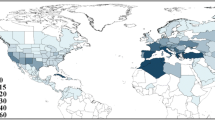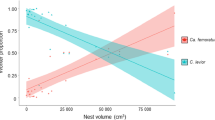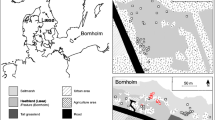Summary
The ant L. longispinosus displays geographic variation in its pattern of facultative polygyny (Fig. 2). In nature, nest density and frequency of multiple queening are positively associated over three sites. A putative causal relation between availability of vacant nest sites and polygyny was examined in New York, where a plot was seeded with additional nest sites and monitored for 24 months. Both queen number and worker number per nest on the experimental plot were reduced relative to controls (Fig. 4, Fig. 5), indicating that scarcity of available nest sites influences the pattern of polygyny in this species. The observed demographic changes resulted from fractionation of existing colonies; adding nest sites induced polydomy. Although numbers of adult ants changed with addition of nest sites, the numbers of immatures were no different after 2 years (Table 1), suggesting that the population was undergoing growth to expand into the additional sites. These results are the first direct experimental evidence linking polygyny to an ecological parameter for any ant species.
Similar content being viewed by others
References
Abrams J, Eickwort GC (1981) Nest switching and guarding by the communal sweat bee Agapostemon virescens (hymenoptera: Halictidae). Insectes Soc 28:105–116
Alloway TM (1980) The origins of slavery in leptothoracine ants (Hymenoptera: Formicidae). Am Nat 115:247–261
Alloway TM, Buschinger A, Talbot M, Stuart R, Thomas C (1982) Polygyny and polydomy in three North American species of the ant genus Leptothorax Mayr (Hymenoptera: Formicidae). Psyche 89:249–274
Anderson M (1984) The evolution of eusociality. Annu Rev Ecol Syst 15:165–189
Bartz SH, Hölldobler B (1982) Colony founding in Myremecocystus mimicus Wheeler (Hymenoptera: Formicidae) and the evolution of foundress associations. Behav Ecol Sociobiol 10:137–147
Berkelhamer RC (1983) Intraspecific genetic variation and haplodiploidy, eusociality, and polygyny in the hymenoptera. Evolution 37:540–545
Brian MV (1983) Social insects. Chapman and Hall, London
Brockmann HJ (1984) The evolution of social behavior in insects. In: Krebs JR, Davies NB (eds) Behavioural Ecology, 2nd ed. Sinauer, Sunderland MA (pp 340–361)
Buschinger A (1968) Monogynie und Polygynie bei Arten der Gattung Leptothorax Mayr (Hymenoptera: Formicidae). Insectes Soc 15:217–226
Craig R, Crozier RH (1979) Relatedness in the polygynous ant Myrmecia pilosula. Evolution 33:335–341
Eickwort GC (1981) Presocial insects. In: Hermann HR (ed) Social insects, vol II. Academic Press, NY (pp 199–280)
Fletcher DJC, Blum MS (1983) Regulation of queen number by workers in colonies of social insects. Science 219:312–314
Fletcher DJC, Blum MS, Whitt TV, Temple N (1980) Monogyny and polygyny in the fire ant, Solenopsis invicta. Ann Entomol Soc Am 73:658–661
Fletcher DJC, Ross KG (1985) Regulation of reproduction in eusocial hymenoptera. Annu Rev Entomol 30:319–343
Gamboa GJ (1978) Intraspecific defense: advantage of social cooperation among paper wasp foundresses. Science 199:1463–1465
Gibo DL (1978) The selective advantage of foundress associations in Polistes fuscatus (Hymenoptera: Vespidae): a field study of the effects of predation on productivity. Can Entomol 110:519–540
Greenberg L, Fletcher DJC, Vinson SB (1985) Differences in worker size and mound distribution in monogynous and polygynous colonies of the fire and Solenopsis invicta Buren. J Kans Entomol Soc 58:9–18
Hamilton WD (1964) The genetical evolution of social behavior. I, II. J Theoret Biol 7:1–52
Headley AE (1943) Population studies of two species of ants, Leptothorax longispinosus Roger and Leptothorax curvispinosus Mayr. Ann Entomol Soc Am 36:743–753
Herbers JM (1982) Queen number and colony ergonomics in Leptothorax longispinosus. In: Breed M, Michener Cd, Evans HE (eds) The biology of social insects. Westview Press, Boulder CO (pp 238–242)
Herbers JM (1983) Social organization in Leptothorax ants: within and between-species patterns. Psyche 90:361–386
Herbers JM (1984) Queen-worker conflict and eusocial evolution in a polygynous ant species. Evolution 38:631–643
Herbers JM (1985) Seasonal structuring of a north temperate ant community. Insectes Soc 32:224–240
Herbers JM (1986) Effects of ecological parameters on queen number in Leptothorax longispinosus (Hymenoptera: Formicidae). J Kans Entomol Soc (in press)
Hölldobler B, Bartz SH (1985) Sociobiology of reproduction in ants. In: Hölldobler B, Lindauer M (eds) Experimental Behavioral Ecology and Sociobiology. Sinauer, Sunderland MA (pp 237–257)
Hölldobler B, Wilson EO (1977) The number of queens: an important trait in ant evolution. Naturwissenschaften 64:8–15
Janzen DH (1973) Evolution of polygynous obligate acacia ants in western Mexico. J Anim Ecol 42:727–750
Jeanne R (1980) Evolution of social behavior in the vespidae. Annu Rev Entomol 25:371–396
Letendre M, Pilon J (1972) Ecologie des populations de Leptothorax longispinosus Roger et Stenamma diecki Emery dans les peuplements forestiers des basses Laurentides, Québec (Hymenoptera: Formicidae). Nat Can Ottawa 99:73–82
Lin N, Michener CD (1972) Evolution of sociality in insects. Q Rev Biol 47:131–159
Litte M (1977a) Behavioral ecology of the social wasp Mischocyttarus mexicanus. Behav Ecol Sociobiol 2:229–246
Litte M (1977b) Aspects of the social biology of the bee Halictus ligatus in New York State (Hymenoptera: Halictidae). Insectes Soc 24:9–36
Metcalf RA, Whitt GS (1977) Intra-nest relatedness in the social wasp Polistes metricus. A genetic analysis. Behav Ecol Sociobiol 2:339–351
Michener CD (1974) The social behavior of the bees: a comparative study. Harvard University, Cambridge MA
Mintzer A (1979) Colony foundation and pleometrosis in Camponotus (Hymenoptera: Formicidae). Pan Pac Entomol 55:81–89
Möglich M (1978) Social organization of nest emigration in Leptothorax (Hym., Form). Insectes Soc 25:205–225
Oster G, Wilson EO (1978) Caste and ecology in the social insects. Princeton University Press, Princeton NJ
Pamilo P (1981) Genetic organization of Formica sanguinea populations. Behav Ecol Sociobiol 9:45–50
Pamilo P (1982) Genetic population structure in polygynous Formica ants. Heredity 48:95–106
Pamilo P (1984) Genetic relatedness and evolution of insect sociality. Behav Ecol Sociobiol 15:241–248
Pamilo P, Rosengren R, Vepsäläinen K, Varvio-Aho S, Pisarski B (1978) Population genetics of Formica ants I. Patterns of enzyme gene variation. Hereditas 89:223–248
Pamilo P, Varvio-Ahno S (1979) Genetic structure of nests in the ant Formica sanguinea. Behav Ecol Sociobiol 6:91–98
Pearson B (1981) The electrophoretic determination of Myrmica rubra microgynes as a social parasite: possible significance in the evolution of ant social parasites. In: Howse PE, Clément JL (eds) Biosystematics of social insects. Academic Press, London (pp 75–84)
Pearson B (1983) Intra-colonial relatedness amongst workers in a population of nests of the polygynous ant Myrmica rubra Latreille. Behav Ecol Sociobiol 12:1–4
Rettenmeyer CW, Watkins JF II (1978) Polygyny and monogyny in army ants (Hymenoptera: Formicidae). J Kans Entomol Soc 51:581–591
Roisin Y, Pasteels JM (1985) Imaginal polymorphism and polygyny in the Neo-Guinean termite Nasutitermes princeps (Desneux). Insectes Soc 32:140–157
Sinclair DF (1985) On tests of spatial randomness using mean nearest neighbor distance. Ecology 66:1084–1085
Smallwood J (1982) Nest relocations in ants. Insectes Soc 29:138–147
Smallwood J, Culver DC (1979) Colony movements of some North American ants. J Anim Ecol 48:373–382
Sokal RR, Rohlf FJ (1981) Biometry. Freeman, San Francisco CA
Strassmann JE (1981) Parasitoids, predators, and group size in the paper wasp, Polistes exclamans. Ecology 62:1225–1233
Strassmann JE (1983) Nest fidelity and group size among foundresses of Polistes annularis (Hymenoptera: Vespidae). J Kans Entomol Soc 56:621–634
Stuart RJ (1985) Spontaneous polydomy in laboratory colonies of the ant Leptothorax curvispinosus Mayr (Hymenoptera: Formicidae). Psyche 92:71–81
Talbot M (1957) Population studies of the slave-making ant Leptothorax dulaticus and its slave Leptothorax curvispinosus. Ecology 38:449–456
Thorne BL (1982) Polygyny in termites: multiple primary queens in colonies of Nasutitermes corniger (Motshuls) (Isoptera: Termitidae). Insectes Soc 29:102–117
Thorne BL (1984) Polygyny in the neotropical termite Nasutitermes corniger: life history consequences of queen mutualism. Behav Ecol Sociobiol 14:117–136
Thorne BL (1985) Termite polygyny: the ecological dynamics of queen mutualism. In: Hölldobler B, Lindauer M (eds) Experimental Behavioral Ecology and Sociobiology. Sinauer, Sunderland MA (pp 325–341)
Tschinkel WR, Howard DF (1983) Colony founding by pleometrosis in the fire ant, Solenopsis invicta. Behav Ecol Sociobiol 12:103–113
Ward PS (1983) Genetic relatedness and colony organization in a species complex of penerine ants. I. Phenotypic and genotypic composition of colonies. Behav Ecol Sociobiol 12:285–299
West MJ (1969) The social biology of polistine wasps. Misc Publ Mus Zool Univ Mich 140:1–101
West-Eberhard MJ (1978) Polygyny and the evolution of social behavior in wasps. J Kans Entomol Soc 51:832–856
Wilson EO (1963) Social modifications related to rareness in ant species. Evolution 17:249–253
Wilson EO (1971) The insect societies. Harvard University Press, Cambridge MA
Wilson EO (1974) The population consequences of polygyny in the ant Leptothorax curvispinosus. Ann Entomol Soc Am 67:781–786
Yamauchi K, Kinomura K, Miyake S (1981) Sociobiological studies of the polygynic ant Lasius sakagamii. I. General features of its polydomous system. Insectes Soc 28:279–296
Author information
Authors and Affiliations
Rights and permissions
About this article
Cite this article
Herbers, J.M. Nest site limitation and facultative polygyny in the ant Leptothorax longispinosus . Behav Ecol Sociobiol 19, 115–122 (1986). https://doi.org/10.1007/BF00299946
Received:
Accepted:
Issue Date:
DOI: https://doi.org/10.1007/BF00299946




